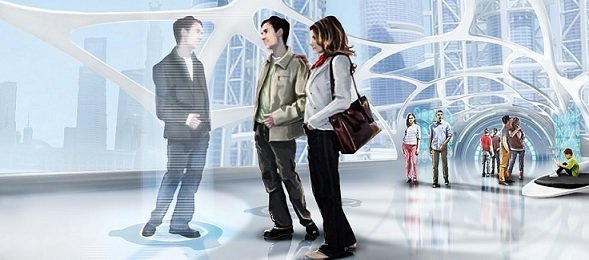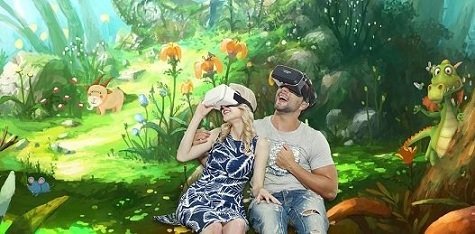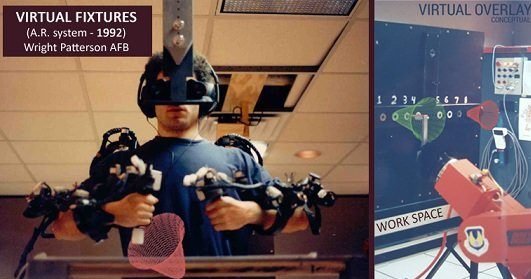Hybridization Of Virtual Reality And Augmented Reality - [The Technology Of Mixed Reality]
Introduction
With the emergence and advances in technology, we have seen many things that weren't thought to be possible now being done with ease and precision. For example; our human intelligence that was ours by prerogative; but with the advent of Artificial Intelligence; is now seen to be replicated in machines. But going a little bit further from our intelligence to our environment; who would have ever imagined that our immediate environment can be simulated using computer devices? But now, technology has provided us with an aid in this. Here we'll be looking at the computer-simulated realities and their hybridization. Welcome again to the potentials embedded in emerging technology.

[Image Source: Flickr. Author: Brother UK. CC BY 2.0 Licensed]
We may have had an idea of the two major computer-simulated realities - which are the “Augmented Reality” and the “Virtual Reality”; but have you ever thought about the possibilities of combining them together to form a single whole technology? Now, that's the idea of the Mixed Reality. But the uninitiated could ask; what da heck is Virtual Reality and Augmented Reality? So, for a clearer understanding, I would briefly give an overview of these realities before driving into what Mixed Reality is. For the purpose of this survey; I will refer to the physical environment we exist in as the "True Reality".
Overview of Virtual Reality (VR)
We'll break down the term for easier understanding: "Virtual" talks about something that is unreal, or non-existent; while "Reality" talks about an entity. So by inference, Virtual Reality is a Computer-Created simulation which initiates an entirely new environment that is different from the True Reality; and as the case may be; cutting your perception completely off from the real world. This means that; the Virtual Reality is actually non-existent, but you would; as it were; have the feeling that it does exist.
I'll give you an example to buttress this point: If you're a gamer, you'd be familiar with "Subnautica game". This game is built with the technology of VR, in such a way that when the user wears the VR headgear (like the popular Oculus Rift or HTC Vive), it would cut their perception off from the outside environment, and it would appear like they are actually inside the gaming environment - and you can even play along with extinct creatures like the megalodon shark - but in the real sense, all these are non-existent; and it's even practically impossible to play in the midst of megalodon shark. So you wouldn't be wrong to infer that the Virtual Reality gives a reflection of an environment which is absolutely (or almost absolutely) created digitally.

[Image Source: Pixabay. CC0 Licensed]
Now we've had a brief overview of the Virtual Reality, we would take a look at the Augmented Reality. But here's an important point I would drop before I continue: The technology of Virtual Reality does not only deal with our visual perception; even our audio perception and all whatnot can be involved and much more; but in this case, it is referred to as the Immersive Virtual Reality - where almost every of our senses are represented in the computer-simulated environment.
Augmented Reality (AR)
Unlike the Virtual Reality that creates an entirely new environment, the Augmented Reality only enhances the already existent environment. Just like the name suggests - "Augment" means to add, enhance, or supplement. So by inference, the user of this technology would still be present in the True Reality, but with some added features to alter their perception a bit. This also means that the True Reality is the bedrock of this; upon which simulations are leveraged on for enhancement.
Hard to understand right? Okay take this little example for elucidation: I'm sure you've heard of the technology of screenless video display; which enables projections to be made from computer devices in mid-air without using any screen whatsoever. This is a good example of AR. The superimposition is made in the True Reality, not creating an entirely new environment. Maybe you would need to have a look at this YouTube video for an insight of how Augmented Reality tech looks like:
Concept of Mixed Reality (MR)
Since we've had a considerably fair overview of the technologies of VR and AR, we will move to the big guy - the Mixed Reality. Like I made mention of in the introduction; the Mixed Reality is a combo of the technologies of the VR and AR in a single platform. In this kind of environment, the user would be present physically in the Real world but with interaction to the simulated world. That is, there is an interaction with both the real world and the virtual world, thus; erasing the line dividing the simulated realities and the True Reality. When the dividing line is completely blurred off, then it is referred to as "Full Immersive Mixed Reality" - and in this case, there could be a switch between the VR and AR and vice versa flawlessly. But in the case where there is partial immersion; it is termed "Perceptual Mixed Reality" - indicating that only part of your senses are involved.
Though this is grouped under the emerging technology, but actually, this idea has been around for a while. A particular technology that was initiated by the U.S Airforce about two decades ago called "Virtual Fixtures" leveraged on the technology of Mixed Reality [ref] - which allows for users to use a perception from a simulated environment to enhance their performance in the real world.

[Virtual Fixtures system. Image Source: Wikimedia Commons. Author: AR Trends. CC BY-SA 4.0 Licensed]
Moving a little further to the side-arms of Mixed Reality; there is the tech we call the "Augmented Virtuality (AV)" - In this type, only the objects from the both realties (Virtual and Real) are needed; while the overall environment remains largely un-mutilated; just like the picture above. And this has been used largely in lieu of the term "Mixed Reality". This also has wider range of application; like in the military - before deploying the soldiers to the war front, a combat scene can be simulated to act as a prep. While the environment would be real, the enemy soldiers would be simulations, and they would be brought in random, to represent a typical war scenario. Once you've scaled through the simulation, then you're good to go.
Also, this can come in handy in other aspects of our lives apart from the military: Like in the educational sector; the scenario of e-learning platform can be used for studies; in which a virtual classroom can be simulated right in the comfort of your home, with your teacher holographically projected onto you. What can't technology do? Maybe with more advances, our real world would completely merge with the digital world.
Conclusion
We may have been aware of the technology of the Virtual and Augmented Realities, but in this post we took a look at the possibilities that have arisen to provide us with the ways of combining them as a single whole. Now, with this combo, the applications have been extended to a broader aspect of our lives - like we have already seen. Tech always rules.
Thanks for reading
References for further reading:
- How Virtual reality works - howstuffworks
- Concept of mixed realities
- Relationship between MR, VR, and AR
- Concept of Augmented realitty
- Mixed Reality - wikipedia
All images are CC Licensed and are linked to their sources


gif by @foundation
I have been thinking quite a bit lately about Augmented and Virtual Reality. What if we were to give a plant the ability to author part of the environment, then superimpose that on the real environment? Could this be used for EcoEducation or for PhytoDomotics? If we allow plants to present themselves in ways humans better accept, will we finally understand their intelligence? Food for thought...
I love the points you raised. Maybe I should look deeper into them and make something out of them.
Thanks a lot
That's the plan! There is not much out there, so my research is slow, but with a little encouragement, I will get there.
This post has been voted on by the steemstem curation team and voting trail.
There is more to SteemSTEM than just writing posts, check here for some more tips on being a community member. You can also join our discord here to get to know the rest of the community!
Hi @samminator!
Your post was upvoted by utopian.io in cooperation with steemstem - supporting knowledge, innovation and technological advancement on the Steem Blockchain.
Contribute to Open Source with utopian.io
Learn how to contribute on our website and join the new open source economy.
Want to chat? Join the Utopian Community on Discord https://discord.gg/h52nFrV